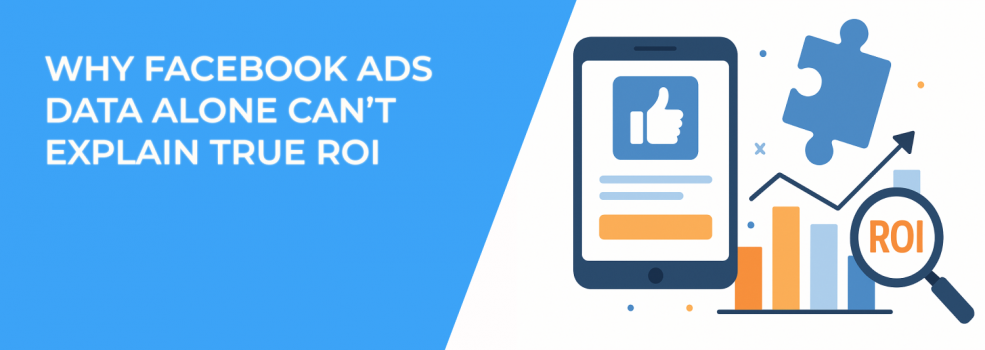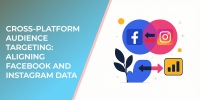Checking Facebook Ads Manager can feel rewarding. Clicks go up. Your cost per lead looks good. Reach expands every day.
But here’s the issue: Facebook Ads data doesn’t always tell you if your money is actually generating profit.
ROI isn’t about impressions or even clicks. It’s about revenue — the real dollars tied to customers who buy, stay, and come back again. And that’s something Facebook alone can’t fully show you.
Why Facebook Ads Data Falls Short
Facebook tracks what happens on its own platform. That includes:
-
Impressions.
-
Click-through rate (CTR).
-
Cost per click (CPC).
-
Conversions captured by the pixel.
These numbers are useful, but they leave big gaps.
Take a SaaS example: Ads Manager shows a $12 cost per lead. Looks great. But in your CRM, only 5% of those leads book a demo, and just 10% of demos turn into paying clients. Your real cost per customer is far higher than $12.
Or picture an e-commerce store. Facebook reports 200 purchases. Shopify shows only 120. Attribution overlap and duplicate reporting create a misleading picture.
These gaps explain why advertisers sometimes scale campaigns that look strong in Facebook’s dashboard, only to realize later that profitability isn’t there.
A related pitfall? Campaigns that don’t deliver at all. If you’ve ever seen “Ad Set May Get Zero,” here’s a guide on how to fix it.
What True ROI Actually Looks Like
To measure ROI properly, you need to connect Facebook Ads data with your business systems. That means tying platform results to:
-
Sales data — link Ads Manager to Shopify, WooCommerce, or your CRM so you can see what’s actually purchased.
-
Customer lifetime value (CLV) — sometimes the first purchase looks small, but a customer acquired through Facebook may spend hundreds over time.
-
Offline conversions — think real estate deals, booked consultations, or in-store sales that never appear in Facebook reporting.
Here’s a scenario: a subscription box brand sees customers spend only $30 on their first order. At first, ROI looks weak. But by tracking CLV, they find these same customers stick around for six months and generate $180 each. Without CLV, they’d cut a campaign that was actually profitable.
Audience definition plays a huge role here too. If you’re sending ads to the wrong people, none of this data will make sense. To sharpen your targeting, see this step-by-step guide.
The Risk of Judging by Facebook Alone
Focusing only on platform data often leads to poor choices.
Imagine this:
-
Campaign A generates $7 leads
-
Campaign B generates $20 leads
At first glance, Campaign A seems like the winner. But when you track actual sales, Campaign B’s leads convert much more often. In the end, Campaign B brings in more revenue, even at a higher upfront cost.
Another case: a restaurant promotes event bookings on Facebook. Ads Manager shows almost no conversions. But when checking phone calls, the owner finds dozens of reservations directly influenced by the ads. Facebook underreported ROI — and pausing those ads would have been a mistake.
This happens frequently. If your ads look busy but aren’t turning into customers, you’ll want to check out Facebook Ads Not Converting: How To Fix It.
How to Move Beyond Facebook Ads Data
To uncover true ROI, advertisers need to track more than clicks and impressions. Here’s how:
-
Use multi-touch attribution. Customers rarely buy after one ad. They might see your Facebook campaign, later search on Google, and purchase after reading reviews. Attribution tools reveal how each touchpoint contributes.
-
Send data with Conversions API (CAPI). The pixel misses things. CAPI lets you feed in server-side events — confirmed purchases, recurring payments, even phone bookings. This sharpens ROI reporting.
-
Measure lead quality. A campaign generating 200 leads may look good until you learn only 20 are serious buyers. Integrating with a CRM exposes which ads bring customers versus empty contacts.
-
Check blended ROAS. Instead of isolating Facebook, calculate revenue vs. spend across all platforms. A campaign might underperform alone but drive awareness that boosts sales through email or Google later.
-
Look at retention. Repeat purchases often decide profitability. An e-commerce brand may find that Facebook buyers reorder every month, while Google buyers purchase once. That changes how you allocate budget.
Your ability to measure ROI also depends on campaign setup. Choosing the wrong objective can leave you tracking vanity metrics. If you’re not sure how to align objectives with real business goals, see Meta Ad Campaign Objectives Explained.
Key Takeaways
Facebook Ads data is valuable, but it’s incomplete.
True ROI comes from combining platform data with:
-
Sales and CRM insights.
-
Customer lifetime value.
-
Offline conversion tracking.
-
Cross-channel attribution.
Clicks and impressions don’t equal profit. The real measure is revenue — and only by looking beyond Facebook’s dashboard can you see it clearly.
The advertisers who track that full journey know where to spend, when to scale, and how to grow sustainably. Those who don’t? They’re left with half the story.

